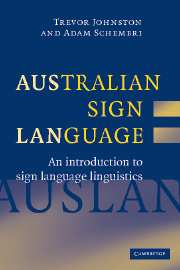Book contents
- Frontmatter
- Contents
- Acknowledgements
- Conventions for sign notation
- 1 Signed languages and linguistics
- 2 Auslan in social context
- 3 Auslan and other signed languages
- 4 Phonetics and phonology: the building blocks of signs
- 5 Morphology: sign formation and modification
- 6 Lexicon: the structure of Auslan vocabulary
- 7 Syntax: the structure of sentences in Auslan
- 8 Semantics and pragmatics: sign meaning and sentence meaning
- 9 Discourse: structure and use above the sentence
- 10 Issues in the study of signed languages
- References
- Index
5 - Morphology: sign formation and modification
Published online by Cambridge University Press: 02 December 2009
- Frontmatter
- Contents
- Acknowledgements
- Conventions for sign notation
- 1 Signed languages and linguistics
- 2 Auslan in social context
- 3 Auslan and other signed languages
- 4 Phonetics and phonology: the building blocks of signs
- 5 Morphology: sign formation and modification
- 6 Lexicon: the structure of Auslan vocabulary
- 7 Syntax: the structure of sentences in Auslan
- 8 Semantics and pragmatics: sign meaning and sentence meaning
- 9 Discourse: structure and use above the sentence
- 10 Issues in the study of signed languages
- References
- Index
Summary
The previous chapter showed that natural signed languages such as Auslan make use of individual meaningful gestures known as signs that have specific formational features. Signs can be broken down into five formational parameters: handshape, orientation, location, movement and non-manual features. It was shown that there are constraints on the combinations of parameters that a sign may have in Auslan, and that these parameters might also be analysed as being organised into formational units analogous to the segment and syllable.
In this chapter, we will introduce the notion of morpheme in Auslan by showing how the parameters of signed languages (which may act as meaningless formational units) described in the last chapter are used to create meaningful units, either alone or in combination. We also show how the use of morphemes in Auslan exists alongside other sources of meaning in the organisation of the language, and will introduce the main processes of sign formation (or derivation) and sign modification (or inflection).
The morpheme in signed and spoken language
In Chapter 4, we saw how the units of handshape, orientation, location, movement and non-manual features act as the smallest formational units of Auslan. The parameters in signs from the core lexicon such as PEOPLE, WORK or BLUE can be identified separately, but in this context they lack a separate meaning. In these signs, the features of handshape, orientation, location and movement combine to produce a unit with a single meaning.
The signs four-years-old and cl:1-person-pass-by, however, differ from the signs people, work and blue, because four-years-old and cl:1-person-pass-by are more complex.
- Type
- Chapter
- Information
- Australian Sign Language (Auslan)An introduction to sign language linguistics, pp. 117 - 156Publisher: Cambridge University PressPrint publication year: 2007

